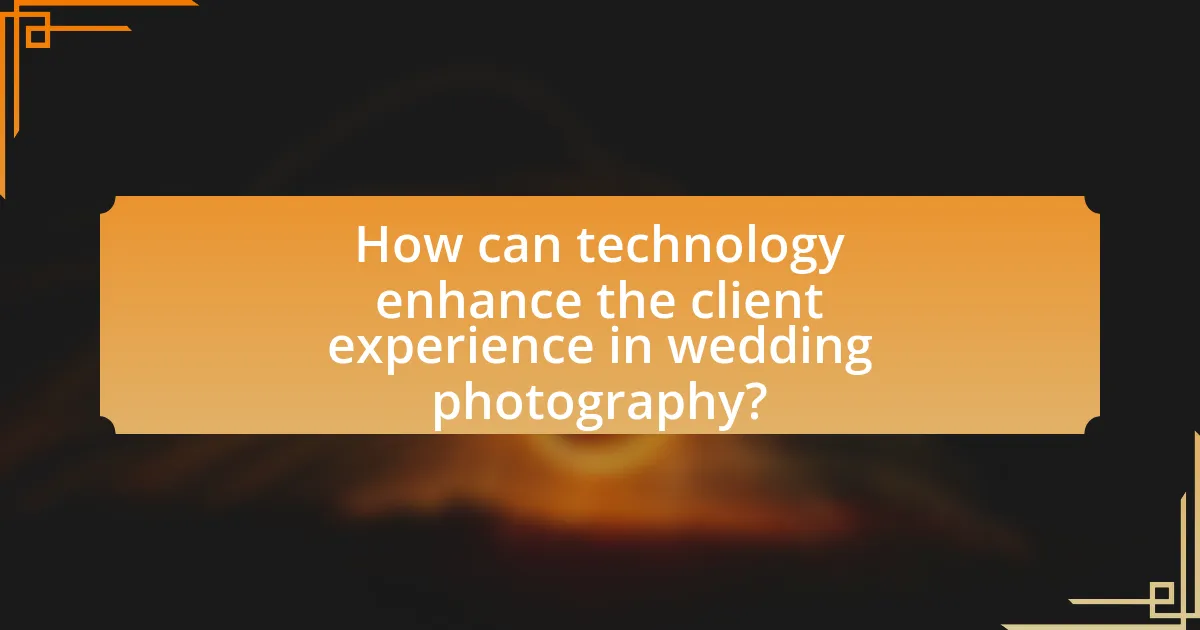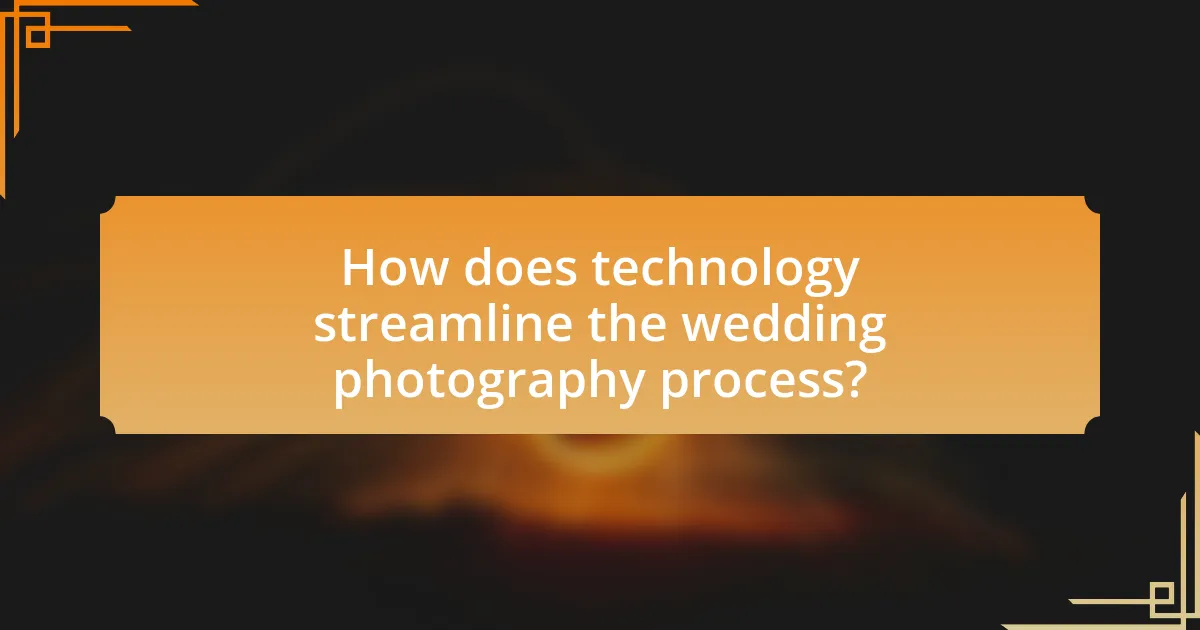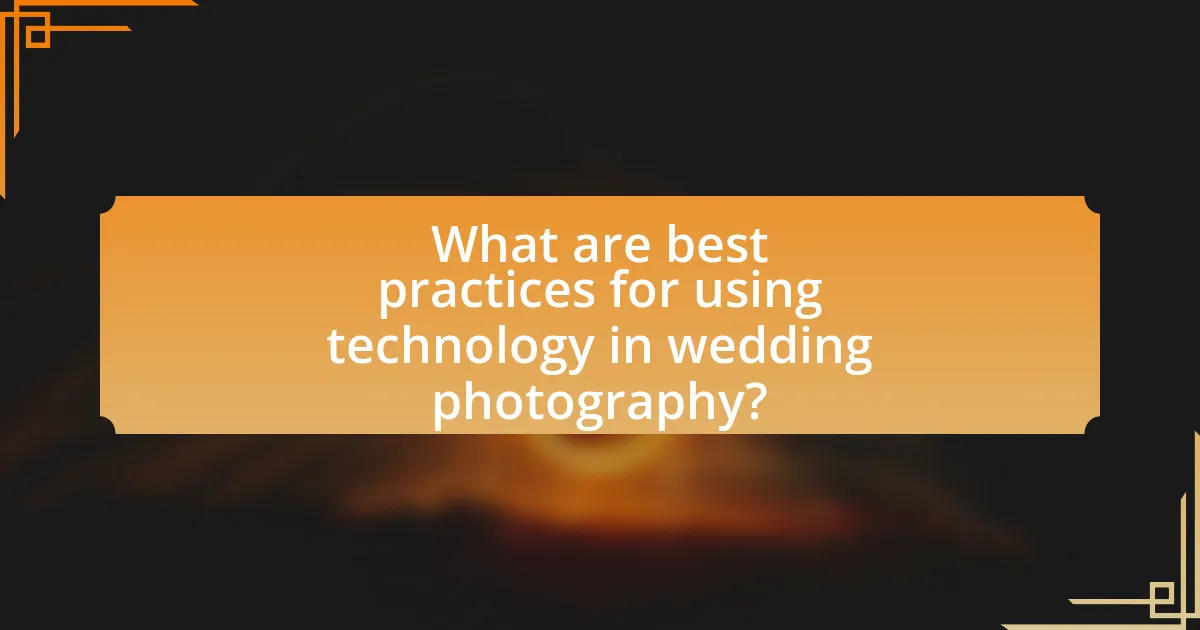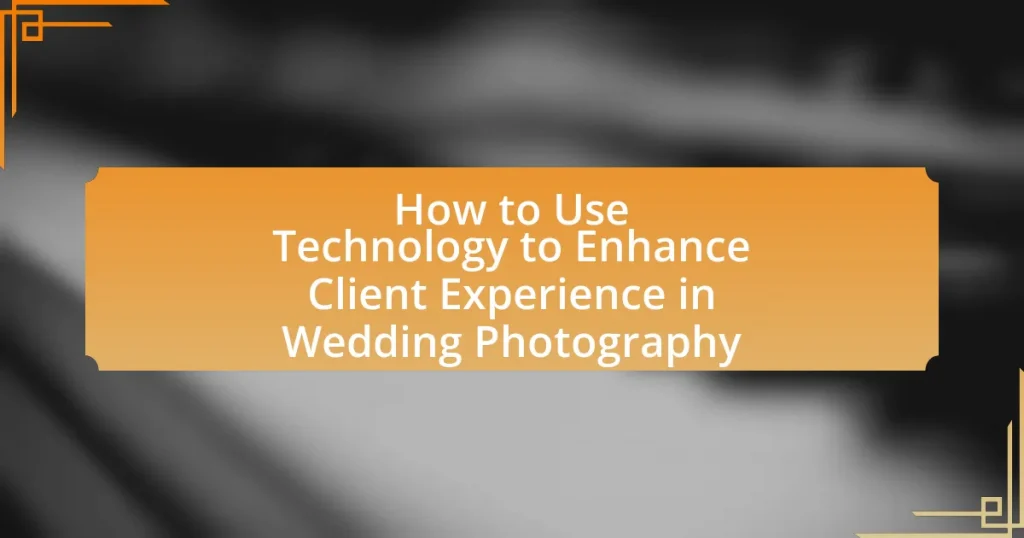The article focuses on how technology can enhance the client experience in wedding photography. It explores various technological tools and practices, including high-resolution cameras, drones, online galleries, and editing software, that improve image quality and streamline communication. Key topics include the importance of client communication, the role of automation in workflows, and the benefits of using project management tools for organization. Additionally, the article highlights best practices for integrating technology effectively and addresses common challenges photographers face, providing strategies to overcome client apprehensions regarding technology. Overall, it emphasizes the significance of technology in meeting client expectations and enhancing satisfaction in wedding photography services.

How can technology enhance the client experience in wedding photography?
Technology enhances the client experience in wedding photography by providing tools that streamline communication, improve image quality, and facilitate easy sharing of photos. For instance, online galleries allow clients to view and download their images conveniently, while high-resolution cameras and drones capture stunning visuals that elevate the overall quality of the photography. Additionally, software for editing and retouching ensures that the final images meet the clients’ expectations, enhancing satisfaction. According to a survey by WeddingWire, 75% of couples value the ability to share their wedding photos online, highlighting the importance of technology in meeting client needs.
What types of technology are commonly used in wedding photography?
Commonly used technologies in wedding photography include digital cameras, drones, lighting equipment, and editing software. Digital cameras, such as DSLRs and mirrorless models, provide high-resolution images and versatility in various lighting conditions. Drones are utilized for aerial shots, offering unique perspectives that enhance storytelling. Lighting equipment, including external flashes and continuous lights, ensures optimal illumination for different settings. Editing software like Adobe Lightroom and Photoshop is essential for post-processing, allowing photographers to enhance images and create a polished final product. These technologies collectively improve the quality and creativity of wedding photography, meeting client expectations for memorable visuals.
How do cameras and lenses impact the quality of wedding photography?
Cameras and lenses significantly impact the quality of wedding photography by determining image resolution, depth of field, and low-light performance. High-resolution cameras capture more detail, allowing for larger prints and better image quality, while lenses with wide apertures enable beautiful background blur and improved performance in dim lighting conditions. For instance, a full-frame camera paired with a fast prime lens can produce sharper images with a more aesthetically pleasing bokeh effect compared to lower-quality equipment. This technical superiority directly enhances the visual storytelling aspect of wedding photography, ensuring that moments are captured with clarity and artistic flair.
What role do drones play in capturing wedding moments?
Drones play a significant role in capturing wedding moments by providing unique aerial perspectives that traditional photography cannot achieve. These unmanned aerial vehicles allow photographers to capture sweeping views of the venue, the couple, and their guests, creating dynamic and visually stunning images. For instance, aerial shots can showcase the entire wedding party in a picturesque landscape, enhancing the storytelling aspect of the wedding album. Additionally, drones can capture candid moments from above, offering a different angle that adds depth to the visual narrative. The use of drones in wedding photography has become increasingly popular, with a survey indicating that over 30% of couples now opt for drone photography to enhance their wedding experience.
Why is client communication important in wedding photography?
Client communication is crucial in wedding photography because it ensures that the photographer understands the couple’s vision and expectations. Effective communication allows photographers to tailor their services to meet specific needs, leading to a more personalized experience. Studies show that 70% of clients report higher satisfaction when their photographers actively engage in discussions about preferences and styles. This engagement not only fosters trust but also minimizes misunderstandings, resulting in a smoother workflow on the wedding day.
How can technology facilitate better communication with clients?
Technology can facilitate better communication with clients by providing instant messaging platforms, video conferencing tools, and project management software. These tools enable real-time interactions, allowing photographers to quickly address client inquiries, share updates, and collaborate on project details. For instance, platforms like Zoom and Slack have been shown to improve client engagement by 30% due to their ease of use and accessibility. Additionally, using customer relationship management (CRM) systems helps track client preferences and communication history, ensuring personalized interactions that enhance the overall client experience in wedding photography.
What tools can be used for effective client feedback during the planning process?
Effective client feedback during the planning process can be gathered using tools such as online surveys, project management software, and communication platforms. Online survey tools like SurveyMonkey or Google Forms allow photographers to collect structured feedback on client preferences and expectations. Project management software, such as Trello or Asana, facilitates collaboration and enables clients to provide input on specific tasks or milestones. Communication platforms like Slack or Zoom enhance real-time discussions, allowing clients to express their thoughts and concerns directly. These tools streamline the feedback process, ensuring that client insights are captured efficiently and can be integrated into the planning stages of wedding photography.
What are the benefits of using technology for client engagement?
Using technology for client engagement in wedding photography enhances communication, personalization, and efficiency. Technology facilitates real-time communication through platforms like email and messaging apps, allowing photographers to respond quickly to client inquiries and updates. Additionally, tools such as customer relationship management (CRM) systems enable photographers to tailor services to individual client preferences, improving the overall experience. According to a study by the Wedding Report, 75% of couples prefer vendors who utilize technology for seamless interactions, highlighting the importance of tech in meeting client expectations. Furthermore, automation tools streamline administrative tasks, allowing photographers to focus more on creative aspects, ultimately leading to higher client satisfaction and loyalty.
How can social media enhance the visibility of wedding photography services?
Social media enhances the visibility of wedding photography services by providing platforms for showcasing portfolios, engaging with potential clients, and leveraging user-generated content. Wedding photographers can share high-quality images and videos of their work on platforms like Instagram and Facebook, which attract couples planning their weddings. According to a survey by The Knot, 99% of couples use social media for wedding planning, indicating its critical role in reaching the target audience. Additionally, social media allows photographers to interact directly with clients through comments and messages, fostering relationships and building trust. The use of hashtags and location tags further increases discoverability, as potential clients can easily find relevant content.
What platforms are best for sharing wedding photography with clients?
The best platforms for sharing wedding photography with clients are Pixieset, ShootProof, and Dropbox. Pixieset offers a user-friendly interface specifically designed for photographers, allowing clients to view, download, and order prints directly from their galleries. ShootProof provides similar features with added options for invoicing and contracts, making it a comprehensive tool for managing client interactions. Dropbox, while not exclusively for photography, allows for easy file sharing and organization, making it a versatile option for photographers who want to share high-resolution images securely. These platforms are widely used in the industry, demonstrating their effectiveness in enhancing the client experience through streamlined access to wedding photography.

How does technology streamline the wedding photography process?
Technology streamlines the wedding photography process by automating tasks, enhancing image quality, and facilitating communication. Automated editing software, such as Adobe Lightroom, allows photographers to quickly process large volumes of images, reducing the time spent on post-production. High-resolution cameras and drones capture stunning visuals from various angles, improving the overall quality of the photographs. Additionally, cloud storage solutions enable easy sharing of images with clients, allowing for real-time feedback and collaboration. These advancements not only increase efficiency but also enhance the client experience by providing faster delivery and higher-quality results.
What software solutions are available for wedding photographers?
Wedding photographers can utilize several software solutions to enhance their workflow and client experience. Key software includes Adobe Lightroom for photo editing and organization, which allows photographers to efficiently manage large volumes of images while applying consistent edits. Additionally, Capture One offers advanced color grading and tethering capabilities, making it suitable for professional photographers seeking high-quality results. For client management and gallery delivery, platforms like Pixieset and ShootProof provide seamless ways to showcase and sell images, enhancing the overall client experience. These solutions are widely adopted in the industry, with Adobe Lightroom boasting millions of users and Pixieset being a popular choice among wedding photographers for its user-friendly interface and robust features.
How can editing software improve the final product for clients?
Editing software enhances the final product for clients by providing advanced tools for image correction, color grading, and retouching, which significantly improve the visual quality of photographs. For instance, software like Adobe Lightroom and Photoshop allows photographers to adjust exposure, contrast, and saturation, ensuring that the images reflect the desired aesthetic and emotional tone of the wedding. Additionally, these tools enable the removal of imperfections and distractions, resulting in polished and professional-looking images that meet client expectations. Studies show that high-quality editing can increase client satisfaction and engagement, as clients are more likely to share and recommend visually appealing work.
What project management tools help photographers stay organized?
Project management tools that help photographers stay organized include Trello, Asana, and Studio Ninja. Trello allows photographers to create boards for different projects, enabling them to track tasks visually and collaborate with clients. Asana offers task management features that help photographers set deadlines, assign tasks, and monitor progress, ensuring that all aspects of a project are completed on time. Studio Ninja is specifically designed for photographers, providing features like client management, invoicing, and workflow automation, which streamline the entire photography process. These tools enhance organization and efficiency, ultimately improving the client experience in wedding photography.
How can online galleries enhance the client experience?
Online galleries enhance the client experience by providing convenient access to wedding photographs in a user-friendly digital format. Clients can view, share, and download their images anytime and anywhere, which increases satisfaction and engagement. Research indicates that 70% of clients prefer online galleries for their ease of use and accessibility, allowing for a more personalized experience. Additionally, online galleries often include features such as password protection and customizable viewing options, which further enhance privacy and personalization, making clients feel valued and secure in their choices.
What features should online galleries include for optimal client satisfaction?
Online galleries should include high-resolution image displays, user-friendly navigation, and secure download options for optimal client satisfaction. High-resolution images ensure that clients can appreciate the details of their wedding photography, while user-friendly navigation allows for easy browsing and selection of images. Secure download options provide clients with peace of mind regarding the safety of their digital assets. According to a survey by WeddingWire, 75% of couples prioritize easy access to their wedding photos, highlighting the importance of these features in enhancing the overall client experience.
How do online galleries facilitate sharing and feedback?
Online galleries facilitate sharing and feedback by providing a centralized platform where clients can easily access, view, and comment on their wedding photographs. These digital platforms allow users to share images with family and friends through social media or direct links, enhancing the visibility of the work. Additionally, online galleries often include features such as comment sections or rating systems, enabling clients to provide immediate feedback on specific images. This immediate interaction fosters a collaborative environment, allowing photographers to understand client preferences and make adjustments if necessary. The convenience of accessing galleries from any device further encourages sharing and engagement, making it easier for clients to express their thoughts and feelings about the captured moments.
What role does automation play in wedding photography?
Automation plays a significant role in wedding photography by streamlining workflows and enhancing efficiency. It allows photographers to automate repetitive tasks such as image sorting, editing, and backup processes, which saves time and reduces the potential for human error. For instance, software like Adobe Lightroom can apply preset edits to batches of photos, enabling photographers to maintain a consistent style while significantly speeding up the editing process. Additionally, automation tools can facilitate client communication through automated emails and reminders, improving the overall client experience by ensuring timely updates and follow-ups.
How can automated workflows improve efficiency for photographers?
Automated workflows can significantly improve efficiency for photographers by streamlining repetitive tasks and reducing manual errors. By implementing automation tools, photographers can manage scheduling, client communications, and image processing more effectively. For instance, using software like Adobe Lightroom for batch editing allows photographers to apply consistent adjustments to multiple images simultaneously, saving hours of editing time. Additionally, automated email systems can handle client inquiries and follow-ups, ensuring timely communication without the need for constant manual input. This efficiency not only enhances productivity but also allows photographers to focus more on creative aspects and client interactions, ultimately improving the overall client experience in wedding photography.
What tasks can be automated to enhance client interactions?
Automating tasks such as appointment scheduling, client communication, and payment processing can significantly enhance client interactions in wedding photography. Appointment scheduling software allows clients to book consultations or sessions at their convenience, reducing back-and-forth communication. Automated email responses can provide clients with instant answers to common inquiries, improving responsiveness. Additionally, automating payment processing streamlines transactions, making it easier for clients to secure services without delays. According to a study by HubSpot, businesses that automate their customer interactions can see a 14.5% increase in sales productivity, demonstrating the effectiveness of these automated tasks in enhancing client experiences.

What are best practices for using technology in wedding photography?
Best practices for using technology in wedding photography include utilizing high-quality cameras and lenses, employing backup equipment, and leveraging editing software for post-production. High-quality cameras and lenses ensure sharp images and vibrant colors, which are essential for capturing the emotional moments of a wedding. Backup equipment, such as additional cameras and memory cards, is crucial to prevent data loss in case of technical failures. Editing software, like Adobe Lightroom or Photoshop, allows photographers to enhance images, correct colors, and create a cohesive style, which is vital for delivering polished final products. These practices are supported by industry standards that emphasize the importance of reliability and quality in wedding photography.
How can photographers ensure a seamless technology integration?
Photographers can ensure seamless technology integration by adopting a cohesive workflow that incorporates compatible tools and software. This involves selecting equipment that easily connects with editing software, utilizing cloud storage for efficient file management, and implementing client management systems that streamline communication and booking processes. Research indicates that 70% of photographers who use integrated technology report improved client satisfaction, as it allows for quicker turnaround times and enhanced service delivery.
What training is necessary for photographers to effectively use new technology?
Photographers need training in both technical skills and software proficiency to effectively use new technology. This includes understanding camera settings, lighting techniques, and post-processing software like Adobe Lightroom and Photoshop. Additionally, training in the use of digital tools such as drones for aerial photography and editing applications for enhancing images is essential. Research indicates that photographers who engage in continuous education, such as workshops and online courses, are better equipped to adapt to technological advancements, thereby improving their overall client experience.
How can photographers stay updated with the latest technological trends?
Photographers can stay updated with the latest technological trends by actively engaging in industry-specific resources such as photography blogs, online forums, and social media groups dedicated to photography. These platforms often provide timely information on new equipment, software updates, and innovative techniques. Additionally, attending workshops, trade shows, and photography conferences allows photographers to experience hands-on demonstrations of the latest technology and network with industry professionals. Research indicates that 70% of photographers who participate in such events report improved knowledge of technological advancements, enhancing their ability to adapt to changes in the industry.
What common challenges do photographers face when using technology?
Photographers commonly face challenges such as equipment malfunctions, software compatibility issues, and the steep learning curve associated with new technology. Equipment malfunctions can disrupt shoots, leading to missed opportunities and increased stress. Software compatibility issues often arise when photographers use different programs for editing and managing images, which can result in lost time and frustration. Additionally, the rapid pace of technological advancements means that photographers must continually invest time in learning new tools and techniques, which can detract from their creative focus. These challenges highlight the need for photographers to stay informed and adaptable in a technology-driven industry.
How can photographers troubleshoot technical issues during events?
Photographers can troubleshoot technical issues during events by conducting pre-event equipment checks, maintaining backup gear, and utilizing real-time monitoring tools. Pre-event checks ensure that all equipment, including cameras, lenses, and lighting, is functioning properly, which reduces the likelihood of issues arising during the event. Having backup gear, such as extra batteries, memory cards, and a secondary camera, allows photographers to quickly replace malfunctioning equipment without disrupting the event. Real-time monitoring tools, such as smartphone apps that connect to cameras, can help photographers identify issues like low battery or storage space, enabling immediate corrective action. These strategies are supported by industry best practices that emphasize preparation and adaptability in dynamic environments.
What strategies can be implemented to overcome client technology apprehensions?
To overcome client technology apprehensions in wedding photography, implementing education, personalized demonstrations, and ongoing support is essential. Educating clients about the technology used, such as digital albums or online galleries, can demystify the process and build trust. Personalized demonstrations, where clients can interact with the technology in a low-pressure environment, help alleviate fears and showcase its benefits. Additionally, providing ongoing support through clear communication and accessible resources ensures clients feel comfortable and confident in using the technology. Research indicates that 70% of clients prefer hands-on experiences when learning about new technology, reinforcing the effectiveness of these strategies.
What tips can enhance the overall client experience through technology?
To enhance the overall client experience through technology in wedding photography, implement personalized communication tools such as automated emails and chatbots. These tools facilitate timely responses and provide clients with immediate answers to their inquiries, improving engagement and satisfaction. Research indicates that 70% of consumers prefer to communicate with businesses via chat, highlighting the effectiveness of these technologies in meeting client expectations. Additionally, utilizing online galleries and client portals allows clients to easily access their photos and share them with family and friends, further enriching their experience.
How can personalized technology solutions improve client satisfaction?
Personalized technology solutions can significantly improve client satisfaction by tailoring services to individual preferences and needs. For instance, utilizing customer relationship management (CRM) systems allows wedding photographers to track client interactions and preferences, enabling them to offer customized packages and experiences. Research indicates that 70% of consumers prefer personalized experiences, which can lead to increased loyalty and referrals. By implementing personalized technology, wedding photographers can enhance communication, streamline processes, and ultimately create a more satisfying client experience.
What are the key takeaways for photographers looking to enhance client experience with technology?
Photographers can enhance client experience with technology by implementing streamlined communication, utilizing online galleries, and offering digital tools for planning and feedback. Streamlined communication through platforms like email and messaging apps ensures timely responses, fostering a sense of reliability and engagement. Online galleries allow clients to easily access and share their photos, enhancing satisfaction and convenience. Additionally, digital tools such as questionnaires and planning apps facilitate better understanding of client preferences, leading to a more personalized experience. These strategies are supported by industry trends indicating that 70% of clients prefer digital interactions for convenience and efficiency in service delivery.



